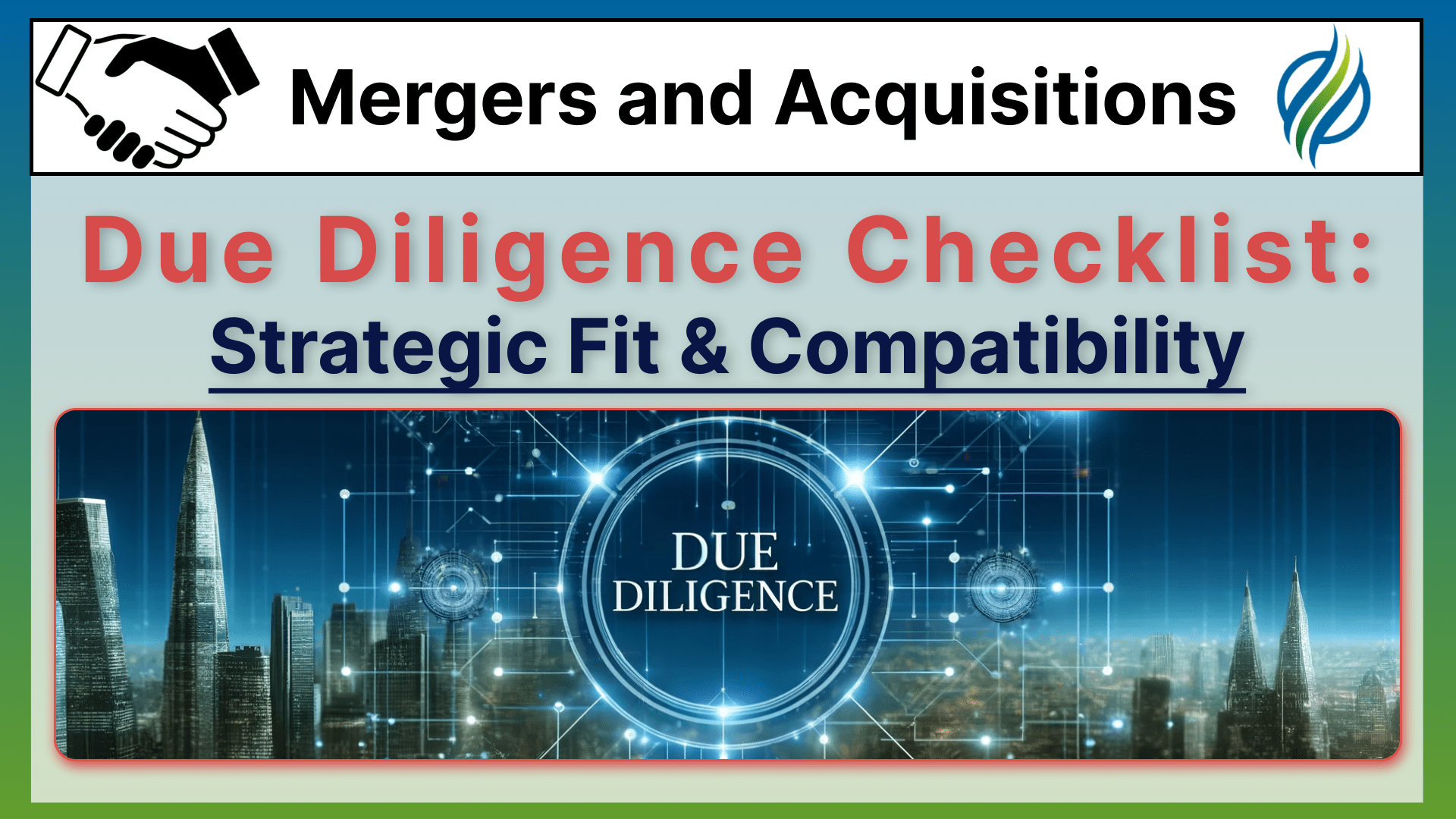When planning a merger or acquisition, understanding strategic fit and compatibility is crucial.
This article dives into the key areas you need to evaluate:
- Strategic alignment,
- Corporate culture,
- Products,
- Services, and
- HR policies.
Knowing how these elements align can make or break your deal.
 Key Takeaways
Key Takeaways
- Assess Strategic Alignment: Ensure the target company's goals align with your long-term strategic objectives for maximum synergy and value.
- Evaluate Cultural Compatibility: Analyze and align corporate cultures to minimize conflicts and ensure smooth integration.
- Review Training Programs: Examine the effectiveness of the target's training programs to support employee growth and integration.
- Analyze Product Fit: Determine how the target's products or technologies complement your portfolio to drive growth and innovation.
- Plan for Integration: Develop detailed strategies for cultural integration and key employee retention to maintain continuity and success.
We’ll explore practical steps for each aspect, highlighting the benefits and importance in M&A due diligence.
By assessing these factors, you can minimize risks, maximize value, and ensure a smooth integration.
Get the most out of this guide by considering how each section applies to your situation.
Use the self-assessment questions to evaluate your current approach.
Ready to master the essentials of M&A due diligence?
Keep reading to unlock insights and strategies for successful integration.
 Table of Contents
Table of Contents
When assessing a potential acquisition, it’s crucial to consider not only the standalone performance of the target company but also how well it fits within your broader organizational strategy.
Evaluating strategic fit and planning for post-merger integration is essential for realizing the full value of the acquisition.
This evaluation involves a detailed analysis of how the target company aligns with your strategic goals, which helps in identifying potential challenges and developing strategies for a smooth transition.
➤ MORE: Check out the FULL Due Diligence Checklist here

Assess Strategic Alignment
Strategic alignment is a critical component of M&A due diligence.
It determines how well the target company’s business, products, and markets align with your strategic goals.
This evaluation helps ensure that the acquisition supports your long-term objectives and enhances overall corporate strategy.
Practical Benefits:
-
Synergy Realization: Identifying areas where the target company’s capabilities can complement your own, leading to increased efficiency and cost savings.
-
Market Expansion: Leveraging the target company’s market presence to enter new markets or strengthen your position in existing ones.
-
Enhanced Competitive Position: Combining strengths to improve competitive advantage in the industry.
Importance:
-
Minimizing Integration Risks: Proper alignment reduces the risk of cultural and operational clashes, ensuring smoother integration.
-
Maximizing Value: Aligning strategic goals helps in fully realizing the potential value of the acquisition.
-
Supporting Long-Term Growth: Ensures that the acquisition contributes positively to your long-term strategic objectives.
Practical Steps:
-
Conduct a Thorough Analysis of Strategic Goals: Review and document your company’s strategic objectives. Compare these with the target company’s goals to identify areas of alignment.
-
Evaluate Historical Relationships: Examine any previous business interactions between your company and the target. Determine if these relationships provide a foundation for strategic alignment.
-
Analyze Market Position and Products: Assess how the target company’s market presence and product offerings complement your own. Identify potential synergies and gaps.
-
Consult with Key Stakeholders: Engage with executives and managers from both companies to gain insights into strategic compatibility. Their input can highlight potential benefits and challenges.
Self-Assessment Questions:
-
How well does the target company’s strategy align with your strategic objectives?
-
How does the target company complement our existing business?
-
What synergies can be realized from this acquisition?
-
Are there any significant strategic mismatches?
-
Are there any historical business relationships that support the strategic fit?
-
What are the key strategic benefits of the acquisition?
-
What are the potential challenges in achieving strategic alignment?
Links to Resources:
-
Industry Analysis Reports: From McKinsey, BCG, or Deloitte.
-
SWOT Analysis Guide: How to conduct a SWOT analysis.
Evaluate Corporate Culture and Alignment with Buyer
Corporate culture encompasses the values, behaviors, and practices that define how a company operates and interacts with its employees, customers, and stakeholders.
Evaluating the cultural compatibility between the target company and the buyer is essential to minimize conflicts and ensure a harmonious integration.
Practical Benefits:
-
Reduced Integration Time: Aligning cultures can streamline the integration process.
-
Employee Retention: Compatible cultures help in retaining key employees and maintaining morale.
-
Smooth Transition: Minimizing cultural clashes ensures smoother operational integration.
Importance:
-
Mitigating Risks: Identifying potential cultural conflicts early can prevent post-merger issues.
-
Ensuring Cohesion: A cohesive culture supports unified business operations and strategic goals.
-
Enhancing Productivity: A compatible culture fosters a positive work environment, boosting productivity.
Practical Steps:
-
Conduct Cultural Assessments: Use cultural assessment tools and surveys to evaluate the target company’s corporate culture. Compare the results with the buyer’s corporate culture to identify similarities and differences.
-
Analyze Mission, Vision, and Values: Review the mission, vision, and values statements of both companies. Assess how well these align and where there may be discrepancies.
-
Observe Workplace Practices: Conduct site visits to observe the target company’s workplace practices and environment. Identify any practices that differ significantly from the buyer’s practices.
-
Engage with Key Stakeholders: Hold discussions with key stakeholders, including management and employees, to gain insights into the company’s culture. Understand their perspectives on the potential merger or acquisition.
Self-Assessment Questions:
-
How similar are the corporate cultures of the buyer and the target company?
-
What are the key differences in values and workplace practices?
-
How well do the mission, vision, and values of both companies align?
-
What are the potential areas of cultural conflict?
-
How will cultural differences impact the integration process?
-
How do employees perceive the corporate culture and potential changes?
-
What steps can be taken to align the two corporate cultures?
Links to Resources:
-
Cultural Assessment Tools: Tools for evaluating corporate culture.
-
HR Policies Guide: Information on standard HR policies and practices.
Review Training and Development Programs
Reviewing the training and development programs of the target company helps assess its commitment to employee growth and development.
Understanding these programs can provide insights into the company’s priorities and how they invest in their workforce.
Practical Benefits:
-
Talent Development: Identifying robust training programs can highlight a focus on employee growth and potential for skill enhancement.
-
Operational Efficiency: Effective development programs contribute to higher productivity and operational efficiency.
-
Employee Satisfaction: Comprehensive training programs often correlate with higher employee satisfaction and retention.
Importance:
-
Ensuring Continuity: Ensures that employee development continues post-merger, maintaining operational standards.
-
Identifying Gaps: Highlights areas where training programs may need to be improved or aligned with the buyer’s standards.
-
Supporting Integration: Well-structured programs can facilitate smoother integration of employees into the new organizational structure.
Practical Steps:
-
Obtain Information on Training Programs: Request detailed information about the target company’s training and development programs, including schedules, content, and delivery methods.
-
Evaluate Program Effectiveness: Assess the effectiveness of these programs by reviewing performance metrics, employee feedback, and success stories.
-
Compare with Industry Standards: Benchmark the target company’s training programs against industry standards to identify strengths and areas for improvement.
-
Assess Opportunities for Integration: Determine how the target company’s training programs can be integrated with your own. Identify potential synergies and areas for collaboration.
Self-Assessment Questions:
-
What training and development programs are in place?
-
How effective are these programs in developing employee skills?
-
How frequently are training programs reviewed and updated?
-
What opportunities exist for employee growth and advancement?
Links to Resources:
-
Training Program Evaluation: Guides on evaluating training programs.
-
Employee Development Tools: Online platforms for employee training and development.
Evaluate Product, Service, or Technology Fit
Determining if the target company provides products, services, or technology that you, as the buyer, don’t have is essential.
Assessing the potential benefits of these additions to your organization’s portfolio can help identify areas for growth and diversification.
Practical Benefits:
-
Portfolio Diversification: Adding new products or technologies can diversify your offerings and reduce dependency on existing products.
-
Market Expansion: New products or services can open up new markets or enhance your position in current markets.
-
Innovation Enhancement: Acquiring advanced technologies can boost your innovation capabilities and keep you competitive.
Importance:
-
Identifying Growth Opportunities: Evaluating product fit helps in identifying potential growth areas and revenue streams.
-
Assessing Integration Challenges: Understanding product or technology compatibility helps in planning for seamless integration.
-
Enhancing Competitive Edge: Acquiring unique products or technologies can strengthen your competitive position.
Practical Steps:
-
Conduct a Product Inventory: Review the target company’s product and service offerings. Document their features, benefits, and market positions.
-
Analyze Market Impact: Assess the potential market impact of adding these new products or services to your portfolio. Consider market demand, competition, and potential synergies.
-
Evaluate Technological Compatibility: Determine the compatibility of the target company’s technology with your existing systems. Identify any potential integration challenges.
-
Consult with R&D Teams: Engage with research and development teams to understand the technological advancements and innovations the target company brings.
Self-Assessment Questions:
-
What new products, services, or technologies does the target company bring?
-
How complementary are these offerings to the buyer’s existing portfolio?
-
What is the potential market impact of adding these new offerings?
Links to Resources:
-
Market Research Reports: Comprehensive market analysis and data.
-
Technology Integration Guides: Resources on integrating new technologies.
Evaluate HR Policies, Practices, and Employee Morale
Evaluating the human resources and cultural fit of the target company is essential for a successful acquisition.
This involves reviewing HR policies, employee agreements, and cultural compatibility to identify strengths and areas for improvement.
Practical Benefits in Terms of M&A Due Diligence:
-
Employee Retention: Understanding HR policies helps in developing strategies to retain key talent post-acquisition.
-
Operational Continuity: Effective HR practices ensure smooth day-to-day operations during the transition.
-
Improved Morale: Assessing employee morale provides insights into potential areas of concern and helps in planning interventions.
Importance:
-
Ensuring Compliance: Reviewing HR policies ensures that all legal and regulatory requirements are met.
-
Identifying Integration Challenges: Understanding differences in HR practices helps in planning for a smooth integration.
-
Supporting Employee Transition: Addressing employee morale and satisfaction is crucial for maintaining productivity and engagement during the transition.
Practical Steps:
-
Review HR Policies and Procedures: Obtain and review the target company’s HR policies and procedures, including recruitment, onboarding, performance management, and benefits. Assess how comprehensive and up-to-date these policies are.
-
Analyze Employee Morale and Satisfaction: Conduct employee satisfaction surveys and review the results. Identify areas of high and low employee morale and the underlying causes.
-
Assess Compensation and Benefits: Evaluate the compensation and benefits packages offered by the target company. Compare these with industry standards and the buyer’s offerings.
-
Review Turnover Rates and Retention Strategies: Analyze employee turnover rates and the effectiveness of retention strategies. Identify any patterns or trends in employee turnover.
-
Engage with HR Professionals: Hold discussions with the target company’s HR professionals to understand their perspectives on HR practices and employee morale. Gather insights on any ongoing HR initiatives or challenges.
Self-Assessment Questions:
-
How comprehensive and up-to-date are the target company’s HR policies and procedures?
-
What are the current levels of employee morale and satisfaction?
-
How competitive are the compensation and benefits packages?
-
What are the patterns and trends in employee turnover rates?
-
How effective are the retention strategies in place?
-
How do the company’s HR policies compare to industry standards?
Links to Resources:
-
HR Policy Templates: Standard HR policy templates and guides.
-
Employee Satisfaction Surveys: Tools for conducting employee satisfaction surveys.
Plan for Cultural Integration and Retention of Key Employees
Planning for cultural integration and the retention of key employees is essential for ensuring a smooth transition and maintaining business continuity.
This involves developing strategies to align cultures, retain critical talent, and address potential challenges.
Practical Benefits:
-
Seamless Transition: Well-planned cultural integration ensures a smooth transition, minimizing disruptions.
-
Key Talent Retention: Retaining key employees helps maintain business continuity and preserves institutional knowledge.
-
Enhanced Morale: Effective cultural integration fosters a positive work environment, boosting morale and productivity.
Importance:
-
Ensuring Business Continuity: Planning for cultural integration is crucial for maintaining operational stability during the transition.
-
Maximizing Value: Retaining key employees ensures that the intellectual and operational assets of the target company are preserved.
-
Supporting Long-Term Success: A well-integrated culture supports the long-term success of the merged entity by fostering collaboration and unity.
Practical Steps:
-
Develop a Cultural Integration Plan: Create a detailed plan for integrating the corporate cultures of the buyer and the target company. Include strategies for addressing cultural differences and fostering a unified culture.
-
Identify and Retain Key Employees: Identify key employees who are critical to the success of the merged entity. Develop retention plans and incentives to ensure these employees remain with the company.
-
Implement Communication Strategies: Develop clear communication strategies to keep employees informed and engaged throughout the integration process. Address any concerns and provide regular updates on the progress of the integration.
-
Provide Training and Support: Offer training and support to help employees adapt to new systems, processes, and cultural changes. Provide resources for employees to voice their concerns and seek assistance.
-
Monitor Integration Progress: Establish metrics and regularly monitor the progress of cultural integration and employee retention efforts. Adjust strategies as needed based on feedback and performance data.
Self-Assessment Questions:
-
What is the detailed integration plan for the acquisition?
-
What are the key areas that need to be integrated?
-
Who are the key employees, and what plans are in place to retain them?
-
How will you manage communication during the integration?
-
How effective are the communication strategies in addressing employee concerns?
-
What resources are required for the integration process?
-
What training and support are provided to help employees adapt to changes?
-
How is the progress of cultural integration and retention efforts monitored?
-
How long is the integration process expected to take?
-
How will key integration milestones be tracked and measured?
-
What are the estimated costs of integration?
-
What are the potential risks and challenges in the integration process?
Links to Resources:
-
Integration Planning Guides: Comprehensive guides on integration planning.
-
Change Management Resources: Tools and techniques for effective change management.
FAQs - Frequently Asked Questions About Determing Strategic Compatibility Between Businesses

Why is strategic alignment important in mergers and acquisitions?
It ensures the acquisition supports your long-term goals.
It minimizes risks and maximizes value.
Learn More...
Strategic alignment ensures that the target company's objectives and operations complement your own, creating synergies that can lead to increased efficiency, market expansion, and competitive advantage.
By aligning strategically, you reduce the risk of operational conflicts and integration issues, making the post-merger integration process smoother and more successful.
How can I assess cultural compatibility in an acquisition?
Use cultural assessment tools and surveys.
Compare mission, vision, and values.
Learn More...
To assess cultural compatibility, start with cultural assessments and surveys to evaluate the core values, behaviors, and practices of the target company.
- Review the mission, vision, and values statements of both companies.
- Conduct site visits to observe workplace practices.
- Engage with key stakeholders to understand their perspectives on the merger.
Identifying similarities and differences helps predict potential conflicts and plan for a harmonious integration.
What are the benefits of reviewing the target company's training and development programs?
It reveals commitment to employee growth.
It highlights potential areas for improvement.
Learn More...
Reviewing training and development programs provides insights into the target company's priorities regarding employee skill enhancement and growth opportunities.
Effective programs contribute to higher employee satisfaction, retention, and productivity, which are crucial during the integration phase.
Identifying gaps allows you to enhance these programs post-merger, ensuring a smooth transition and continuous development.
How do I evaluate the product fit of a target company?
Assess how their products complement your portfolio.
Consider potential market impact and integration challenges.
Learn More...
Start by conducting a thorough inventory of the target company's products and services, documenting their features, benefits, and market positions.
Analyze the potential market impact of these new offerings and how they fit with your existing portfolio.
- Assess technological compatibility to identify integration challenges.
- Engage with R&D teams to understand the innovations the target company brings.
This evaluation helps identify growth opportunities and areas for diversification.
What steps should I take to retain key employees after an acquisition?
Identify and develop retention plans for key employees.
Implement clear communication and support strategies.
Learn More...
To retain key employees, first identify those critical to the success of the merged entity and develop tailored retention plans and incentives for them.
Implement clear and consistent communication strategies to keep all employees informed and engaged throughout the integration process.
- Provide training and support to help employees adapt to new systems and processes.
- Establish metrics to monitor the progress of retention efforts and adjust strategies based on feedback and performance data.
These steps help maintain continuity, morale, and productivity post-merger.
What role do HR policies play in the success of an acquisition?
They ensure legal compliance and operational consistency.
They affect employee satisfaction and retention.
Learn More...
HR policies are crucial in ensuring that all legal and regulatory requirements are met, providing a foundation for consistent and fair treatment of employees.
Comprehensive and up-to-date HR policies contribute to high levels of employee satisfaction and retention, which are vital for maintaining productivity and morale during and after the transition.
- Reviewing HR policies helps identify strengths and areas for improvement.
- Aligning these policies with industry standards supports smooth integration.
In Summary…
In mergers and acquisitions, evaluating strategic fit and compatibility is essential to ensure a successful integration and achieve long-term growth.
This article provided an in-depth look at key areas to assess, including strategic alignment, corporate culture, training programs, product fit, and HR policies.
By following the practical steps outlined, entrepreneurs can minimize risks, realize synergies, and create a cohesive and productive merged entity.
Applying this information practically allows you to:
-
Identify Synergies: Understand how the target company’s strengths complement your own, enhancing operational efficiency and market presence.
-
Smooth Integration: Plan for cultural alignment and retention of key employees to maintain morale and business continuity.
-
Informed Decision-Making: Make well-informed acquisition decisions by thoroughly evaluating strategic alignment, product fit, and HR practices.
By using the insights and strategies discussed, you can navigate the complexities of M&A with greater confidence and success.
Ready to take the next step in your M&A journey?
Schedule a consultation call with our business initiative experts or use our contact form to get personalized advice and support.
Subscribe to the Initiative Newsletter for the latest insights and updates.
Follow us on X for more tips and strategies.
Don’t wait—start optimizing your M&A strategy today!
Sources
- McKinsey & Company: For strategic planning and cost management insights.
- Boston Consulting Group: For strategic planning and cost management insights.
- Deloitte: For industry analysis and M&A strategies.
- Prosci: For change management resources.
- SHRM: For HR policies and practices guidelines.
- Culture Amp: Tools for evaluating corporate culture.
- Training Magazine: Guides on evaluating training programs.
- Udemy: Online platforms for employee training and development.
- Statista: Comprehensive market analysis and data.
- TechRepublic: Resources on integrating new technologies.
- SurveyMonkey: Tools for conducting employee satisfaction surveys.
- PwC: Comprehensive guides on integration planning.


